Many may know CARL HUNTER for his musical roots as a member of “The Farm” in the 80’s and 90’s thanks to hits like “Groovy Train” and “All Together Now”. Others may know him for his artistic work designing CD jackets and sleeves for the group or from his short films in the late 90’s when he started writing, directing, and producing. And still others may know him for his collaborations with writer Frank Cottrell Boyce which include films like the British comedy Grow Your Own, or Hunter’s short film adaptation of Cottrell Boyce’s Accelerate, or his work as a photographic illustrator on The Forgotten Coat, a children’s book by Cottrell Boyce. And now CARL HUNTER collaborates with Frank Cottrell Boyce again with the wonderful little gem, SOMETIMES ALWAYS NEVER.

With an ensemble cast led by Bill Nighy and Sam Riley, SOMETIMES ALWAYS NEVER is the story of a family trapped in the past but going through the motions of life in the present. Patriarch Alan is a proper working-class Englishman. A widowed, Scrabble-obsessed, tailor, Alan’s life is “just so” but it feels as if something is missing. The tidiness is a bit too tidy. His son Peter is married to a lovely woman and is father to high-schooler Jack. On the surface, the family looks complete, but as we watch and listen, we learn about Michael. Michael is the missing tile in the family’s Scrabble board of life. Splitting his time between obsessing over finding Michael and showering some affection and attention on grandson Jack, Alan has little engagement with Peter; that is until there is a report of a body that has been found that fits Michael’s description. As comes as no surprise, Peter goes with his father to the coroner’s office, but even then, Alan pushes him to the side, leaving him to sit outside while he looks at the body. Elated that the body is not that of his son, Alan’s hopes of finding Michael are renewed, especially when he is intently engaging online with a Scrabble player whose word usage and style of play convince him that this is Michael giving him clues to find him.
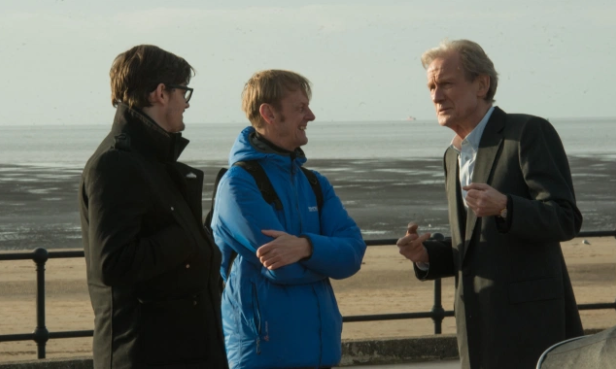
CARL HUNTER’s interests are eclectic and diverse, his passion boundless, and his drive to find interesting ways to tell stories, be it in music or film, is exhilarating. During our conversation, it was impossible not to explore a bit of music as we took a walk down memory lane to the 80’s music LA music scene when Carl was with The Farm and they played the Roxy where he met Lemmy which led to a trip to the Viper Room where they met up with Blondie, Steve Jones, the Sex Pistols, and two members of Talking Heads. His excitement talking about music equals that when talking about the making of SOMETIMES ALWAYS NEVER. One can’t help notice that a common thread between his life in music and his life as a film director is the love of “indie” and “small gems.” CARL HUNTER is a lover of those small music venues which he played at when with The Farm and which he frequented, many of which are now long gone, like CBGB in New York which gave birth to groups like The Ramones, Patti Smith, The New York Dolls. “All these people broke the mold which opened the doors for lots of other bands to ‘be’ other bands. You wouldn’t have good music without them. How sterile music would have been if it hadn’t been for those people going ‘No, let’s do a Year Zero. Let’s do…!’ Johnny Thunders kind of changed people’s lives as a guitarist. You wouldn’t have the Sex Pistols without Johnny Thunders. And David Bowie. Those are the people who changed music.”
And like those musicians who “broke the mold”, to a large extent so does CARL HUNTER with his approach to filmmaking, and particularly with SOMETIMES ALWAYS NEVER. Drawing on photographers like Saul Leiter and Gregory Crewdson for some visual influence and melding that with the approach of Japanese filmmaker Kore-eda using minimal to no close-ups, Hunter then ups the ante exploring the idea of “how we imagine”. Looking to the writings of Aristotle and his ruminations on imagination, Hunter removed sound for prolonged periods to create an awkwardness, exploring and experimenting with the concept of removing elements to “leave it up to the viewer to try and think what someone’s feeling, to imagine what someone’s feeling.” For example, can a viewer be made to feel the emotional or internal awkwardness a character is feeling by removing a sensory element from a scene? Wanting “the imagined” to be a big part of SOMETIMES ALWAYS NEVER, he also wanted to make the film enjoyable and accessible, much of which comes from performances and, of course, music.
With a wonderful warmth, intelligent articulation, and terrific sense of humor, we dove into Hunter’s thought process and approach for the making of SOMETIMES ALWAYS NEVER in this exclusive conversation, covering all of the cinematic bases from cinematography to production design to sound to music to performance to Scrabble. A quirky delight that dazzles with powerful eye-popping color, geometric angular precision in production design and cinematography, and understated nuanced performances from Bill Nighy and Sam Riley, SOMETIMES ALWAYS NEVER is stylized sartorial elegance, absolutely gorgeous, and a triple word score M-U-S-T-S-E-E.

Well, I have to congratulate you, Carl. First of all, for pairing up on projects with Frank Cottrell Boyce. I am a huge fan of Frank’s work as a screenwriter. RailwayMan and Goodbye, Christopher Robin are two of my favorites. I just love what Frank writes. But then I look at this film, Carl. Sartorial elegance, stylized, absolutely gorgeous. Each frame is even more beautiful than the last. I was visually spellbound by this film. But then you throw in this incredible structure, set it with the family and all the pieces, very similar to each one as a Scrabble tile. And we meet Alan, and then you add Peter to that. Then you add Margaret and you add Sue and Jack and Rachel, until ultimately we get to that third act where this very linear progression now morphs as we see them sitting in a circle around a campfire with the empty chair, very akin to the blank, wild card tile in a Scrabble game, representing Michael. I am so in love with that metaphoric construct and all the pieces that we see unfold here, with your visual design, with Richard Stoddard’s cinematography piggybacking on Tim Dickel’s production design. That’s a very important triumvirate with this film. So I’m curious how you developed the visual tonal bandwidth and specifics for this film.
My background, initially, is I trained as a designer. I’m actually a graphic designer by trade and I worked as a designer and as an art director. So I understand prints quite well. I’m used to composition, I’m used to typography. So, the world of design is a world I’m very familiar with. I’ve worked in the visual industries all my life, so I’m very familiar with photography, with illustration, and some kinds of visual arts. That’s what I do. So design is very important to me. From the very first day when we were putting this film together, I produced the scrapbook, quite a hefty scrapbook, which was full of reference material, which I could then use as a way of communicating with Richard [Stoddard], who was the DOP and Tim [Dickel], who was the designer. So we had this really wonderful, very easy relationship because we all spoke the same language. But in order to get in our language, I’d feed the material and say, “I really like this type of interior. I like this type of wallpaper. I like this type of whatever.” But completely by accident, I was in London in pre-production, very early o and I was with Tim and Richard. Gregory Crewdson, who is a very well known American photographer, had an exhibition which had just opened in London. I was around the corner from it so I took Richard and Tim to the exhibition and I made them look at every single photograph and question it. So we talked. I’d stop them, say, “Okay, what do you think of this photo? What you like about it?” And they’d say, well, I like this.” I’d say “Why?” They’d say “Well the line’s really strange.” “Why is it strange?” Okay. And we looked at every single photograph on every floor. We were there for hours. And then after we left the exhibition, we went to the pub around the corner and we had pints. From that second onwards, we had a language which meant communication was very easy. So in a weird way, the film has a nod to America in a lot of its influences, which are very European, but also there’s a lot of influences, which nod towards people like Crewdson and others.
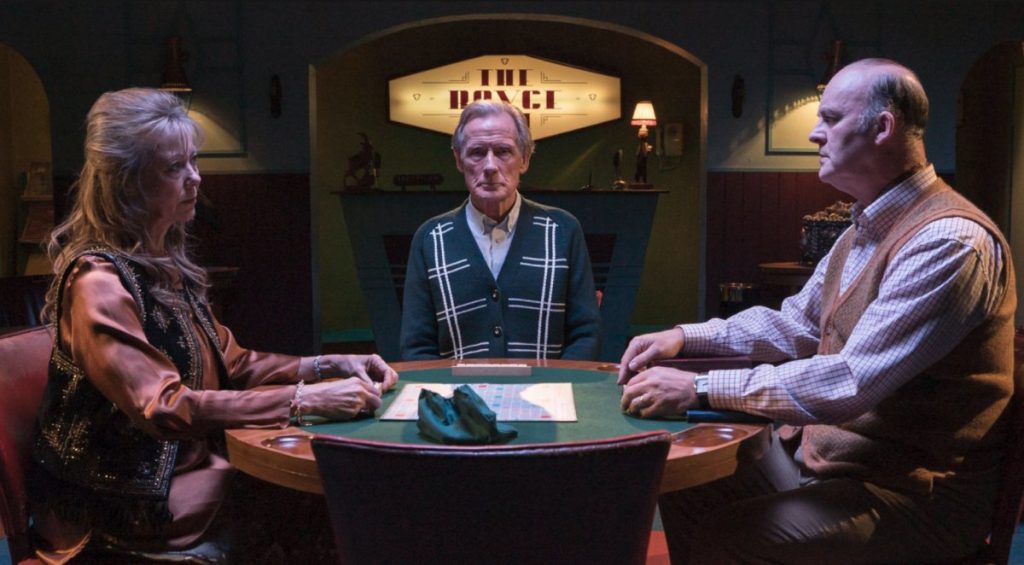
The lighting is just so striking. In some moments it’s very theatrical. And it plays so well with the geometric design of rooms. We get those beautiful archways, a lot of doors, narrow hallways. And the way that you and Richard play with light through windows, we get a lot of silhouetteing. I love the shots through the frosted glass, through the steam on the windows, or at the bus stop. It’s haunting and it makes you feel like Michael is there like a specter over everybody. It’s very emotionally evocative to see that. But it’s the geometry of the designs and then how Richard moves the camera. You pretty much keep things in mid-shots, closeups, but for when we expand and Alan is out walking on the beach alone, a tiny little figure. And you see and feel his loneliness in this beautiful world that makes you wonder is he missing the actual beauty of this world around him. But it’s just so elegant, so elegant, Carl.
Oh, thanks. Regarding shooting through the kind of frosted glass and through kind of foggy or steamed-up windows, that’s a direct nod to the New York photographer Saul Leiter. In my scrapbook, I kept and had cut out a number of Saul Leiter photographs and kept them in that scrapbook. So when we were shooting the morgue scene, or the bus stop scenes, Richard or Tim would go, “What are you thinking?”. And I’d show them the photographs and say, “That’s what I’m thinking.” And they’d go “Great, we understand, we know exactly what to do.” So, yeah in a weird way the films got quite a lot of nods to America. But also there were kind of other things. I had seen a Japanese film a number of years ago by the director Kore-eda and he’d made this beautiful film called Maborosi, which is a very sad film, but it’s also a very beautiful film. I was haunted by it after seeing it and then thinking, why am I so haunted by this film? There’s something about it. It’s not the story, it’s the look.
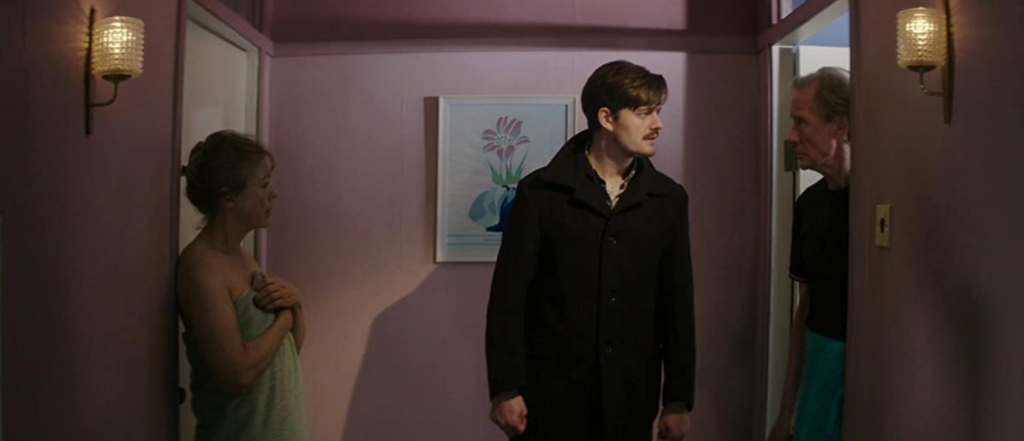
I worked out that what Kore-eda had managed to do – shoot a film where there were no close-ups. Well, hardly any close-ups, or maybe none, in fact. So when I kind of wandered towards making SOMETIMES ALWAYS NEVER that was in my mind. Can I shoot a film where I refuse to shoot close-ups? Not because I don’t like them, but I wonder if, in this instance, there’s a film grammar that I can play with whereby the kind of emotional weight of the film and not really using lenses to kind of get that weight across, I wonder if I could do it just by performance. So it was a bit of an experiment in a way. But it seems to have worked because there is a kind of dissonance to the film. Throughout the film, Bill’s character Alan doesn’t want anyone near him. Everyone is kept at arm’s length from him all the time. As an audience, that’s where I was thinking. I think we should be arm’s length all the time. In fact, when we’re in the morgue scene when it’s shot through frosted glass, there was the temptation to set up a body on a table with a cloth over it and take the camera inside, but I didn’t want to do that. I wanted to stay outside the room because the room or rather the frosted glass represents Bill’s kind of emotional armor. He doesn’t want you inside. He doesn’t want the armor cracked. Not yet anyway. So it was far better to leave the camera outside the room.
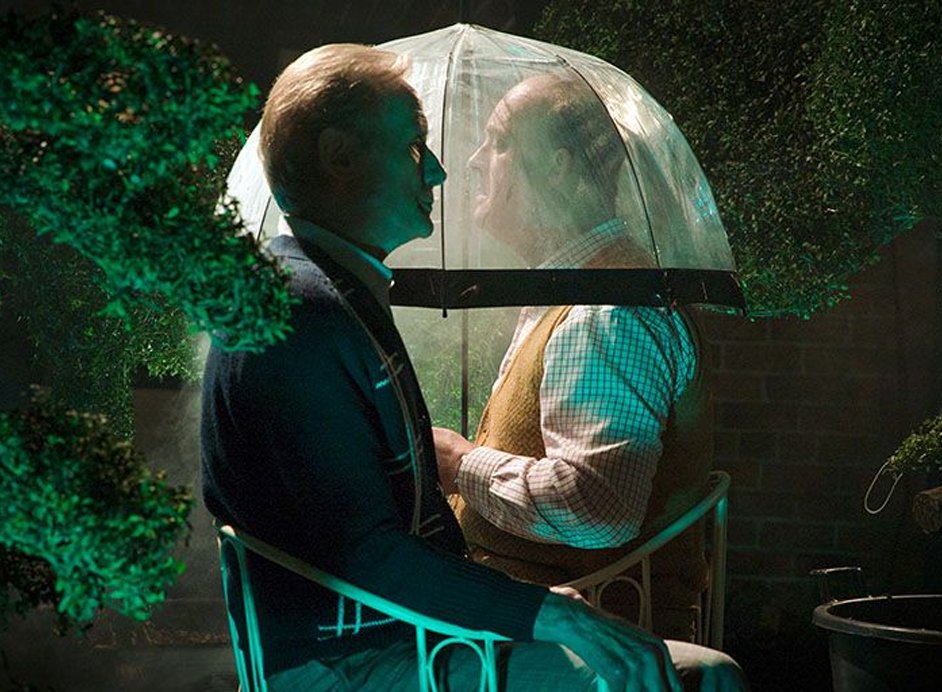
Then I’m also quite interested in the idea of how we imagine. So for instance, if we think the camera is in the room and we see a body and a corpse and cloths and sheets and whatever, then what do we imagine? We imagine less because we can see it. It’s illustrated. I was more interested in, if we don’t go in the room the only thing left remaining as a viewer is you have to imagine. And its that space between the imagined and what we can illustrate is kind of what interested me. That’s why I took all the sound out. So when that scene happens, when the slow camera kind of creeps in with the frosted glass, I don’t know if you noticed, but I took every bit of sound off the film.

Every bit! I’m glad you mentioned that because that’s one of my big notes to myself is how you celebrate periods of silence. Sam Auguste, your sound editor, did an amazing job with the sound design, the meticulousness of the sound design. But the fact that you strip away all sound is so powerful and it forces your imagination to work, to think “What is happening? What is he feeling?” as that camera’s moving in. And you do this in a couple other areas too. I just find that so compelling when directors do that, but particularly with an emotional piece like this.
Well again, it goes back to film grammar. I became very fascinated by the idea of the imagined and, this is very pretentious, but I’d started reading Aristotle’s thoughts on imagination and to imagine. I became quite, I wouldn’t say obsessed, but I became quite interested in it, thinking, “Well, you watch your film and the story is played out in front of you and it’s enjoyable or frightening or whatever it’s meant to be. But, is there a bit where you can remove all that and leave it up to the viewer to try and think what someone’s feeling, to imagine what someone’s feeling?” So for instance, when I took the sound out of that scene, what I was hoping to achieve, which seems to have worked actually, is if you have prolonged periods of silence, it gets awkward.
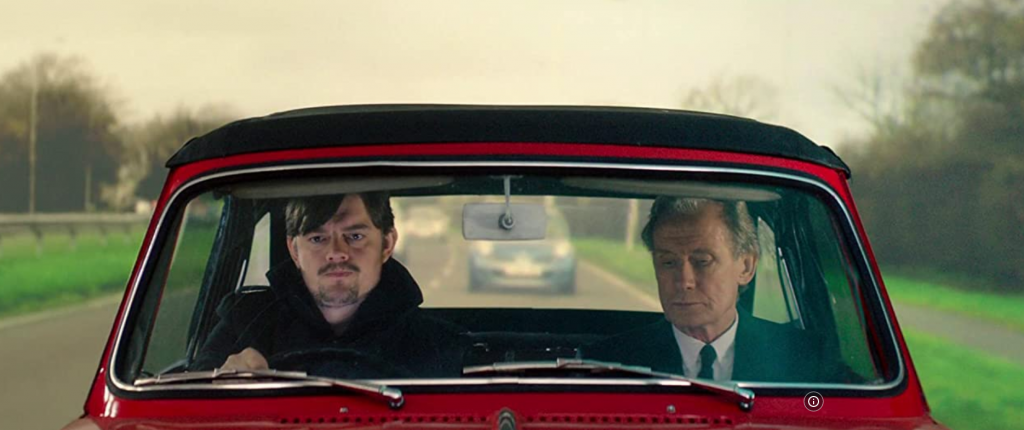
Very uncomfortable.
The longer you keep silence going, it gets more awkward. So I wondered if in cinema or even at home, when you watch the film and you watch that scene, the absence of sound makes it awkward and makes it very uncomfortable. So, therefore, could I make the viewer feel how Alan is feeling in the film at that moment in time? Again, it was kind of experimental, but I quite like that in film. I’m quite interested in films that do try to reshape things and look at ways of telling stories. I love all sorts of films. I’m a big film fan. But I wanted to make a particular film whereby the imagined becomes a big part of it. So, that’s where I was going but I also wanted to make the film enjoyable and very accessible. So it’s a film which answers yes, with nods to Aristotle, where at the same time, you don’t need to know any of that. You just need to know “When I watch this film, by the end of it, will I feel better?” And the answer is yes, you will feel better.

Yes, absolutely. Something else that you do is that makes this very accessible, is that it’s about a family. I love this for the pure fact that this isn’t what we normally see, where everybody is totally screwed up and there’s all kinds of friction and violence and the kids are train wrecks. We don’t have any of that here. This is a middle-class family. They work, they keep their homes clean, they dress nicely, the kid goes to school with no problems. It’s lovely to see that, to see the normality and generosity of spirit, so to speak, as much as family has for one another, at some points. You enhance that by steeping us in the past; we’re in this 1960s, Rat Pack, mod mindset almost with the production design, with the costume, with the use of color. And you go so far as to use rear projection when they’re driving in a car. Yet you very judiciously will insert the computer or the cell phone, to play the word games on. But we feel a gentler, nicer time when we watch this family.
Well, that’s to do with the production design, and the look of the film is basically one very big visual metaphor. As you watch the film, what you’re looking at is a time when that family was in a world at peace. They’re trapped in the past. They’re trapped in the past through grief. The look of the film looks dated. However, you know it’s contemporary because of computers and phones. But there’s something about the film where you think, “This is a long time ago.” And that’s because “it’s a long time ago” is the point where the eldest son disappears and the family then is frozen in time from that moment onwards. They’re trapped in grief. And until that’s resolved, then the family can’t move on. Lucky enough, in the story later on in the film, Bill’s character Alan does move on. He finds a way of moving on, as does his son and as does the family. The look of the film is about being trapped in the past.

It’s beautiful. It really is. You can feel the grief. In today’s times, I think we all long for the calmness of that period even though there may be some grief for this family. But I think now more than ever, it’s that kindness, that calmness that we feel and that comes across equally in the film as well. I have to say, Carl, you did make me chuckle with the shipyard scenes. I don’t know if this was intentional but you have one ship called “Nirvana” and the other one that is “Nauti Bouy” which many will pronounce “naughty boy.”
Oh, yes! That was an accident. The shipyard we filmed in, there were two boats that were dry-moored in the shipyard. But they were the names on the boats. It was nothing to do with us. And also “Nauti-bouy” is spelled wrong on the boat! [Correct spelling would be b-u-o-y.]

Yes, it is! Oh, I chuckled at that because on the one side “Nirvana” and for Alan, “Nirvana” would be finding Michael. On the other side “Nauti-bouy” would be Michael for leaving. The irony is that the whole family loves Scrabble but “Nauti-bouy” is spelled incorrectly! The double entendre that’s happening there is just fabulous. But, another element of this film that is truly fabulous, Carl, is the music, the emotionality of music. But even more than the scoring itself, the instrumentation. At the hour seven mark where we’ve got Peter in the diner and we see a convergence of colors with green, blue, and yellow, and of course, yellow and blue make green, but the camera pulls back and we see red-checkered tablecloths. Peter goes off and he sits alone in the dark with just a light silhouetting him and we hear the piano and feel a sadness, a melancholy, but then slowly a triangle comes in and we hear the little clink almost as if it’s childlike, maybe tears. Slowly, we get a little bit more musicality in there. And then we move to the camper and everything in there is childhood things about Michael. It’s that kind of musical attention that elevates this even higher. What kind of discussions did you have with Edwyn [Collins] and Sean [Read] about the music for this film? And because of your own musical background, did you have input into the instrumentations and arrangements?
Well, the film music started with the fact I needed a composer for the film, but I didn’t want a traditional film composer. I wanted a songwriter. Because it was an independent film, I wanted someone really from the world of independent music, to kind of represent that. Edwyn Collins, to me, is the king of independent music. I was a huge fan of Edwyn and his band Orange Juice and, going back many years, I kind of knew Edwyn. So I thought it would be better to get a songwriter rather than a traditional kind of film score person, a composer. So Edwyn said he’d do it, which I was thrilled at, and then he recruited Sean; also my son, Jake, who’s normally in the room with me, but don’t know where he is now, is a musician. So the three of them went to Scotland and I would send them clips of the film, like rough cuts of scenes. Then they’d play with themes and melodies. But in terms of me having any kind of input, not really. I kind of kept out of it. I let them write songs and play guitars and do whatever they did. But I kept pretty much out of it. I used to go up to Scotland quite a few times and I’d stay there for a couple of day and kind of direct the music in terms of, they take a scene and I’d say “That’s a bit too jolly” or “That’s a bit too miserable” or “Actually, could you put something in here?” But that’s about it really. The music is their thing. I loved being around it because I was a big fan of Edwyn and still am, and working on music for a film is nothing other than great fun anyway. And I love being in recording studios. So just being there, for me, was just great fun. I loved to listen to Edwyn sing and hone melodies and talk about music. It fed to the environment which is just swimming in creativity. Every second of it is absolutely creative. Three people making music in a very enjoyable way. All you’ve got to do is watch it and you just think, “I could just watch these three all day. They’re happy and they’re making brilliant music. Like musical alchemists.” Great fun to work with. The soundtrack is brilliant.
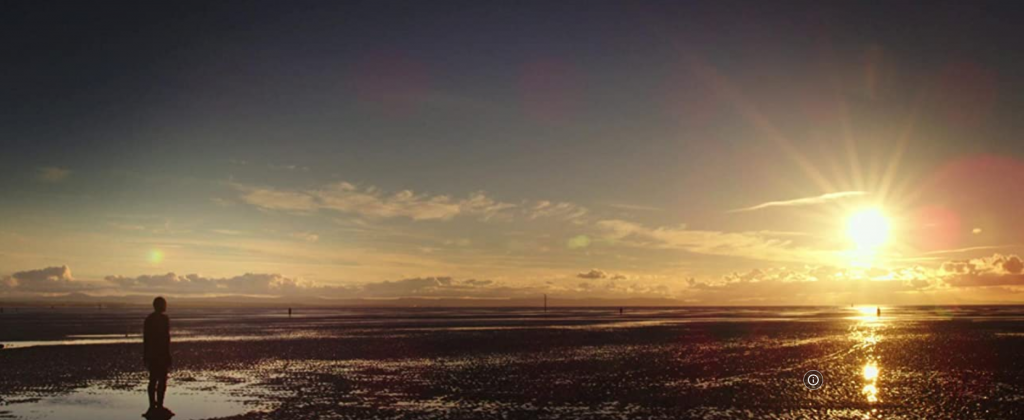
I love the music. And here again, it’s hats off to Sam [Auguste] with the sound editing, because the music is so effectively edited and mixed within the film. It all just adds to that elegance that follows through on every level of this film, Carl. Elegance and stylization come through and it just radiates. Before I let you go Carl, while I know you’ve done a lot of shorts and TV, this was your first feature directorial, so I’m curious, what was that learning curve like for you as a director to jump head-first into a feature?
I’ve got a background of film anyway because I’ve done about 30 broadcast documentaries in Britain. So I’ve been around film, I’m used to film. I’m used to being behind a camera. But directing a feature film is slightly different. I have to say it was a pleasant experience, but it was amazing. It was made a lot easier for me because of the people around me really, producers, writers, Bill [Nighy] was a complete and utter – he was like an anchor to me. He was so supportive. But all the cast were, Sam [Riley], Alice [Lowe], Tim [McInnerny], Jenny [Agutter], Bill, you name it. They were on my side because they knew that I was making a very particularly strong visual film. They loved the idea of this British film which had this incredibly strong kind of visual statements and they bought into it. So they just wanted to help me. They wanted to try anything out I suggested. So in a weird way, it sounds like it was really daunting to direct your first feature film, but it wasn’t as daunting as you think. To say it was “almost easy” wouldn’t be true, but what it is, is that everything is hard if you’ve got nobody around you to pick you up or help you. Then life is very difficult. But when you’re doing something quite tricky but you’re surrounded by a circle of people who are there to prop you up and support you, actually, it’s not that hard. Like, a great Director of Photography. If I struggled with an idea, Richard straightaway would know the answer. Sometimes with the performance, I’d speak to Bill or Alice or Sam and they’d say, “Well, what are you thinking?” I’d say, “Well, this is what’s in my head. But what do you think?” And we’d talk for ages about the character and then we’d choose. So, there was a lot of support. I think if you had no support, if it was like a job interactor, where people just hand off your jobs to show up on set, shoot, and then disappear, I would imagine that’d be difficult and probably quite unpleasant. But my experience was the opposite of that. It was like being in a band. Like being in The Beatles…before they broke up.
So what’s next for Carl Hunter?
Frank has just finished the new script for a new film. And I’m expecting it to pop into my email any second. I’ve read most of it. But he said there’s a slight problem, which I need to resolve. But the new script is pretty much written. That’s really good. And it’s a very good script that’s funny. It’s called Literally Timbuktu. If you remember, look out for Literally Timbuktu maybe a year from now. When filming starts, hopefully, people start chatting about it, then you’ll go “Ah, I remember that title!” Debbie, thank you for your very flattering interview and your love of the Ramones. What’s not to like?
by debbie elias, exclusive interview 06/12/2020












